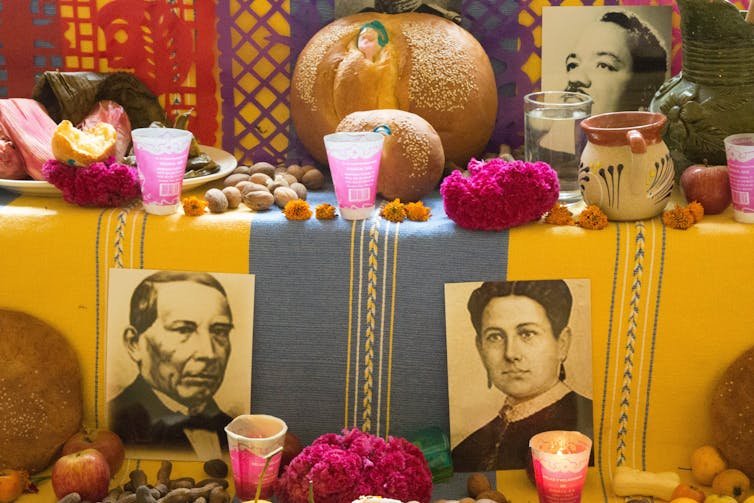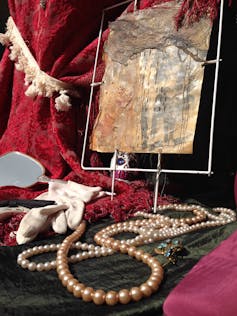Grief rituals: what Australia can learn from the Day of the Dead
- Written by Colleen Nordstrom, Lecturer in Palliative Care, La Trobe University
Australians have few public commemorations of death. We have funerals, roadside memorials and annual Anzac services, but only certain deaths are remembered. For most of us, death and mourning are private affairs. Individuals have to find their own way to preserve the memory of their beloved dead, and process their grief.
This is not the case in other cultures, such as Mexico, where the Day of the Dead is celebrated on November 1-2. This is a time for communities, families and friends to gather in celebration as they remember and honour their dead. I am part of a project, working with the Australian Mexican community, exploring how Day of the Dead can open up discussions on dying, end-of-life choices, and grief in Australia. Community and art are central to Day of the Dead, and I believe Australians can learn from these aspects of it.
The Day of the Dead’s origins can be traced to ancient times. Unlike in many Western cultures, here, death is the guest of honour – and like birth, it is viewed as a natural event in the cycle of life. Symbols of death and mortality, such as skeletons, are part of the festivities.
Ofrendas are the centrepiece of Day of the Dead festivities. Decorated like a Christmas tree, ofrendas traditionally hold flowers, candles, photos of the deceased as well as their favourite food items – as well as pan de muertos (“bread of the dead”), a sweet bread shaped into round loaves with faces made of coloured dough.
 Traditional ofrenda, includes crimson cockscomb and gold marigold flowers (known by some as ‘flower of the dead’) and food items such as tamales (top left) and pan de muertos (top centre). Oaxaca, Mexico.
Copyright Colleen Nordstrom
Traditional ofrenda, includes crimson cockscomb and gold marigold flowers (known by some as ‘flower of the dead’) and food items such as tamales (top left) and pan de muertos (top centre). Oaxaca, Mexico.
Copyright Colleen Nordstrom
After a symposium discussing the Day of the Dead in Melbourne, participants told us that learning about the Mexican tradition had helped them deal with their own grief.
One told how she’d had “very little experience of death” but thought that it provided a “good supportive mechanism” for her to “think about death while celebrating life”. In retrospect, she can now see how it helped her cope with the recent diagnosis of “a very serious cancer” in a young family member. At first, she said, “I was freaking out” but she was able to quickly reframe her thoughts into something more “productive, not just doom and gloom”.
Another participant was transformed by the experience. She said,
we don’t always want to share death or talk about it so this made me look at it in a different light. Something new was being offered, a new awareness, a new way of looking at death and dying and grieving.
When her sister died a few months ago, she credits her new thinking to how it “helped get me through”. She concludes, “I can honestly say it’s not logically something you can explain. I can only tell you how it made me feel”.
Death-related rituals play a crucial social function in communities. Anthropologists and sociologists have long argued that funeral and grief rituals have existed in every society, for as long as history records. Rituals maintain stability during times of personal chaos. They provide a social container for the expression and containment of strong emotions.
 Australian example of a Mexican-inspired ofrenda. Carol Jones (nee Penglis), Día de los Muertos Ofrenda (detail), 2014.
Photograph: Karen Annett-Thomas
Australian example of a Mexican-inspired ofrenda. Carol Jones (nee Penglis), Día de los Muertos Ofrenda (detail), 2014.
Photograph: Karen Annett-Thomas
In response to violent deaths in Australia, such as the 2014 Lindt cafe hostage crisis in Sydney, even if the dead are strangers to us, we leave flowers and cards in public spaces not typically reserved for mourning. These “spontaneous shrines” are personally motivated, and are not initiated or encouraged by officials.
Unexpected death calls us to remember that – like the ephemeral art created for Day of the Dead and its use of fresh-cut flowers – life is short. And it can end at any time.
We urgently need our community to consider the topics of death and grief. Aspects of Day of the Dead allow us – through respectful cultural appreciation and exchange – to think through our relationships to each other. In the face of our shared mortality, that can only be a good thing.
Everyone need not necessarily take up celebrating Day of the Dead, in whole, or in part - individuals may have other rich cultural practices to draw upon. But to ignore the wisdom offered by this ancient tradition, especially in the absence of personally meaningful, death-related rituals, misses an important opportunity, and I would argue, is foolhardy.
Colleen is speaking at the “Romancing the Skull” exhibition’s Day of the Dead Festival at the Art Gallery of Ballarat on November 1, 2017.
Authors: Colleen Nordstrom, Lecturer in Palliative Care, La Trobe University
Read more http://theconversation.com/grief-rituals-what-australia-can-learn-from-the-day-of-the-dead-86047





